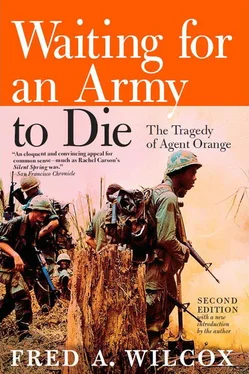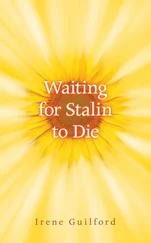“I never knew how naïve I was,” Wares sighs, calling for another round and refusing my offer to pay, “until I got involved in this. I just never really knew. There are things that have happened that until this day I just can hardly believe. I mean, you hear about the CIA and ASIO [the Australian counterpart to the CIA] and you hear how the CIA can destroy people, but in Australia it’s a different world, and I never really considered any of it real; it was all TV stuff to me. But I believe now it’s all real. Every bit of it is real . Do you know, for example, what happened to the scientist that Bob mentioned earlier, the one who was assigned by the government to test herbicides in Vietnam. His name was George Lugg, and he was an honorary major during the war. Part of his job was to advise the US Army on the use of herbicides and pesticides in Vietnam, and he was a brilliant scientist, absolutely brilliant. We got ahold of some of his papers and reports and, of course, a copy had always gone right to the chemical warfare people at Fort Detrick. Brilliant fellow, and when he came back from Vietnam they said he had a ‘personality disorder,’ that’s what they called it anyway. And do you know what they did to him, and we’ve only just discovered this. He ended up in a convalescent home, an old man’s home, and he’s fifty-seven. Fifty-seven years old! None of us knew anything about Lugg until the association got going; then we discovered that George Lugg existed and who he was and what he did, and that he was in an old man’s home in Victoria. So we tried to set up a meeting with him and a journalist, but a ‘salmonella’ outbreak occurred that weekend at the home and no one could see George Lugg.” [8] According to Australian authors John Dux and P. J. Young, George Lugg suffered “what was described as a ‘breakdown’” in 1973. But a friend of Lugg’s, Mr. Geoffrey Foot, says that following the breakdown Lugg “became very irrational in his behavior and the government fobbed that off as psychiatric disorder, but it was certainly more than just a mental breakdown; it was a distinct physical breakdown in his appearance and everything.” Although Lugg was obviously exposed to herbicides over a period of time, no one is absolutely certain whether his physical and emotional collapse was caused by his exposure. “In his day he was a very brilliant man,” says his sister, Mrs. D. A. Hardy, “but at fifty he lost it all.”
Wares lights a cigarette and watches the smoke curl lazily around his fingers. “I’m not really a melodramatic person. I don’t see ghosts everywhere, and I’m not paranoid at all, but there’s pieces to this puzzle that are missing and I wonder if we’ll ever find them and put the whole thing together before we all die. Sometimes I really doubt it.”
Bob Gibson and his wife have been advised by a physician that because of Gibson’s exposure to toxic chemicals they should “under no circumstances” consider having children. Thirteen years after his army discharge, Gibson still suffers from skin rashes, insomnia, and stomach problems. But in spite of his many maladies, Gibson feels that he is more fortunate than many veterans. One of the most mysterious aspects of toxic chemical poisoning is that different species of animals are affected to a greater or lesser degree by substances like dioxin; it might very well be the case that human beings exposed to the same quantity of dioxin will react in dissimilar ways. For some the exposure may manifest itself in skin rashes, chronic allergies, migraine headaches, and personality changes, while others die in a matter of months or years from cancer, liver disease, kidney failure, and what has been called “wasting disease.” [9] Some scientists believe that dioxin attacks the enzyme system, lowering the body’s ability to fight infection and making the exposed individual more susceptible to disease. Experimental rhesus monkeys given minute quantities of dioxin develop rashes, lose weight, become listless and literally waste away in a matter of days or weeks, depending on the amount of dioxin they ingest.
Still others—like Jim Wares, whose tentmate in Vietnam suffers from chronic allergies and has won the first round with a bout of lymphoma—appears to have escaped the more devastating effects of exposure to toxic chemicals. In short, dioxin has crept through the ranks of Australian and American Vietnam veterans, maiming some, destroying others, and leaving the survivors bewildered, angry, afraid. Bob Gibson and Jim Wares are survivors, but they know too many veterans who, while still in their prime of life, have succumbed to the cumulative effects of toxic poisoning.
They knew Collin Simpson, a thirty-five-year-old Vietnam veteran who had been fighting to stay alive for a number of years. Dying of lymphoma, Simpson was absolutely certain that his illness could be traced to his exposure to toxic chemicals, including Agent Orange, during his ten-month tour of duty in Vietnam. He died just a few days before he was to become the subject of the first major Agent Orange case in Australia.
After he returned from Vietnam, Simpson lived in a suburb of Sydney where the trees had been bulldozed and, just as sketched on an architect’s drawing board, houses had been built in symmetrical patterns. The neighborhood was friendly enough. On weekends neighbors would get together for a barbecue, a game of cards, and a bit of gossip while the children swam, raced their bikes, or bickered over a game of sandlot soccer. But inside some of the homes were men who “bashed” their wives during fits of uncontrollable rages, men whose bodies were covered in patches of chloracne, men who were suffering from rheumatic pains, fevers, and constant headaches. One veteran had suffered two suspected heart attacks and partial paralysis, at the age of twenty-three.
The children in the neighborhood also had problems. In one of the homes lived a five-year-old boy who could recite only one nursery rhyme; in another, a girl who was hyperactive and had to take medication to correct a chemical imbalance in her brain; in still another, a baby had died of cancer at the age of twelve months; and in the Simpsons’ home, the father was dying and his son had asthma, a partially collapsed lung, and a permanent rash on his chest and back.
The men on Monrobe Street knew that things were not right, and they scoffed at the minister of veterans’ affairs, when he claimed that they were suffering from “war neurosis.” Had they been asked to fight again, most of them would have readily returned to the jungles of South Vietnam, even though they could recall walking through defoliated areas, and years later, wondered whether the water they drank or the food they had eaten in Vietnam might be responsible for their present maladies.
Collin Simpson died before his claims that he had been poisoned by toxic herbicides could be proven or disproven. But Simpson’s wife and veterans’ activists requested and received further hearings before the Repatriation Tribunal, a judicial review board with powers to grant dispensation, arguing that Simpson died of “war-related causes” and that his wife and children were entitled to a full was pension. One year after her husband’s death, the tribunal ruled that the claim was valid and granted Mrs. Simpson her pension. In a ruling that Vietnam veterans have called a “worldwide breakthrough,” the tribunal conceded that Simpson’s death might well have been caused by his exposure to toxic chemicals. While unwilling to concede that Simpson’s cancer was definitely caused by his exposure to toxic chemicals, the tribunal emphasized that it had been unable to “disprove the causal relationship.” “This onus,” declared the tribunal, “is not satisfied beyond a reasonable doubt that there was insufficient grounds for granting the claim…. It is a real possibility that the applicant’s malignant lymphoma resulted from his exposure to phenoxyacetic acid herbicides during his period of special service to South Vietnam.”
Читать дальше











